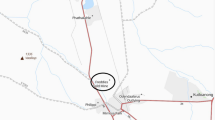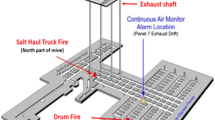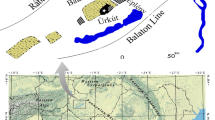Abstract
In this study, dry season radon flux densities and radon fluxes have been determined at the rehabilitated Nabarlek uranium mine in northern Australia using conventional charcoal canisters. Environmental background levels amounted to 31± 15 milli Becquerel per m2 per second (mBq m−2 s−1). Radon flux densities within the fenced rehabilitated mine area showed large variations with a maximum of 6500 mBq m−2 s−1 at an area south of the former pit characterised by a disequilibrium between 226Ra and 238U. Radon flux densities were also high above the areas of the former pit (mean 971 mBq m−2 s−1) and waste rock dump (mean 335 mBq m−2 s−1). The lower limit for the total pre-mining radon flux from the fenced area (140 ha) was estimated to 214 kBq s−1, post-mining radon flux amounted to 174 kBq s−1.
Our study highlights that the results of radon flux studies are vitally dependant on the selection of individual survey points. We suggest the use of a randomised system for both the selection of survey points and the placement of charcoal canisters at each survey point, to avoid over estimation of radon flux densities. It is also important to emphasize the significance of having reliable pre-mining radiological data available to assess the success of rehabilitation of a uranium mine site.
Similar content being viewed by others
References
Adams, M. A. and Hose, J. E.: 1999, ‘Final report: Revegetation of the Nabarlek Uranium Mine’, Consultancy Report to Pioneer Concrete P/L, Adams Ecological Consultants, Subiaco W.A., February 1999.
Akber, R., Lawrence, C., Bollhöfer, A., Martin, P. and Marshman, I.: 2004, 222Rn Activity Flux from Open Ground Surfaces at ERA Ranger Uranium Mine. Internal Report 477, Supervising Scientist, Darwin. Unpublished paper.
Clark, G. H., Davy, D. R., Bendun, E. O. K. and O'Brien, B.: 1981, Meteorological and Radiation Measurements at Nabarlek, Northern Territory, June to July 1979. AAEC/E505, p. 110.
Clements, E. W., Barr, S. and Marple, M. L.: 1980, ‘Uranium mill tailings piles as sources of atmospheric radon’, Natural Radiation Environ. III(2), 1559–1583.
Davy, D. R., Dudaitis, A. and O'Brien, B. G.: 1978, Radon survey at the Koongarra Uranium Deposit, Northern Territory. AAEC/E459, p. 56.
Grabham, M. K.: 2000, An Erosion Assessment of the Former Nabarlek Uranium Mine, Northern Territory, Environmental Science (Hons) Thesis, The University of Newcastle, p. 97.
Hancock, G. R., Grabham, M. K., Martin, P., Evans, K. G. and Bollhöfer, A.: 2005, ‘An erosion and radionuclide assessment of the former Nabarlek uranium mine, Northern Territory’, Sci. Total Environ. (in press).
Jha, S., Khan, A. H. and Mishra, U. C.: 2001, ‘A study of technologically modified sources of 222Rn and its environmental impact in an Indian U mineralised belt’, J. Environ. Radioactivity 53, 183–197.
Kvasnicka, J.: 1996, Radiological Impact Assessment due to Radon Released from the Rehabilitated Nabarlek Uranium Mine Site, Unpublished Report to Queensland Mines Pty. Ltd.
Martin, P.: 2000, Radiological Impact Assessment of Uranium Mining and Milling. PhD Thesis, Queensland University of Technology, Brisbane.
Martin, P., Tims, S. and Storm, J.: 2002, ‘Radon Exhalation Rate from the Rehabilitated Nabarlek Surface’, in J. Rovis-Hermann, K. G. Evans, A. L. Webb and R. W. J. Pidgeon (eds), Environmental Research Institute of the Supervising Scientist Research Summary 1995–2000, Supervising Scientist Report 166, Supervising Scientist, Darwin NT, pp. 18–22.
Martin, P., Tims, S., Ryan, B. and Bollhöfer, A.: 2004, ‘A radon and meteorological measurement network for the Alligator Rivers Region, Australia’, J. Environ. Radioactivity 76, 35–49.
Martin, P., Tims, S., McGill, A., Ryan, B. and Pfitzner, K.: 2005, ‘Use of airborne γ-ray spectrometry for environmental assessment of the rehabilitated Nabarlek uranium mine’, Environ. Monit. Assess. (submitted).
Ott, W. R.: 1990, ‘A physical explanation of the lognormality of pollutant concentrations’, J. Air Waste Manage. Assoc. 40(10), 1378–1383.
Ott, W. R.: 1995, Environmental Statistics and Data Analysis. Lewis Publishers, Ann Arbor.
Porstendörfer, J.: 1994, ‘Properties and behaviour of radon and thoron and their decay products in the air’, J. Aerosol Sci. 2, 219–263.
QML: 1979, Final Environmental Impact Statement: Nabarlek Uranium Project, Arnhem Land – Northern Territory. Queensland Mines Limited.
Rutherford, E.: 1906, ‘Adsorption of the radioactive exhalations by charcoal’, Nature 74, 634–635.
Snedecor, G. W. and Cochran, W. G.: 1989, Statistical Methods, Iowa State University Press, Ames, Iowa.
Spehr, W. and Johnston, A.: 1983, ‘The measurement of radon exhalation rates using activated charcoal’, Radiation Protect. Australia 1(3), 113–116.
Todd, R., Akber, R. A. and Martin, P.: 1998, 222Rn and 220Rn Activity Flux from the Ground in the Vicinity of Ranger Uranium Mine. Internal report 279, Supervising Scientist, Canberra. Unpublished paper.
UIC: 1997, Former Australian Uranium Mines. Uranium Information Centre Ltd, Melbourne. Available at http://www.uic.com.au
UNSCEAR: 2000, Sources and Effects of Ionizing Radiation. United Nations Scientific Committee on the Effects of Atomic Radiation, Report to the General Assembly, volume I: Sources.
U.S. EPA: 2004, Code of Federal Regulations (CFR), Title 40: Protection of Environment, Part 192: Health and Environmental Protection Standards for Uranium and Thorium Mill Tailings.
Waggitt, P. W. and Woods, P. H.: 1998, ‘Nabarlek Uranium Mine, Northern Australia: History, Rehabilitation and Groundwater Studies’, in Proceedings of the Second International Conference on Uranium Mining and Hydrology, Freiberg, Germany, pp. 602–612.
Whittlestone, S., Zahorowski, W. and Schery, S. D.: 1998, ‘Radon flux variability with season and location in Tasmania, Australia’, J. Radioanal. Nuclear Chem. 236, 213–217.
Author information
Authors and Affiliations
Corresponding author
Additional information
2006 Springer. The Australian Government's right to retain a non-exclusive, royalty free licence in and to any copyright is acknowledged.
Rights and permissions
About this article
Cite this article
Bollhöfer, A., Storm, J., Martin, P. et al. Geographic Variability in Radon Exhalation at a Rehabilitated Uranium Mine in the Northern Territory, Australia. Environ Monit Assess 114, 313–330 (2006). https://doi.org/10.1007/s10661-006-4777-z
Received:
Accepted:
Published:
Issue Date:
DOI: https://doi.org/10.1007/s10661-006-4777-z




